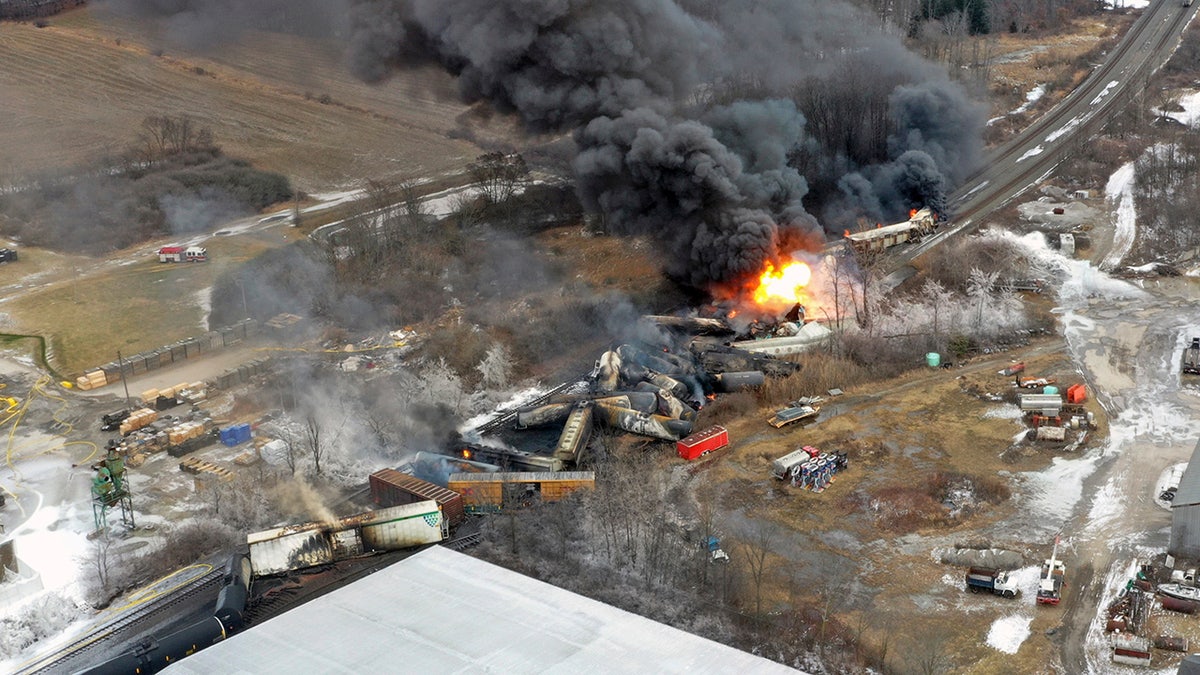
This photo taken with a drone shows portions of a Norfolk Southern freight train that derailed Friday night in East Palestine, Ohio are still on fire at mid-day Saturday, Feb. 4, 2023. (AP Photo/Gene J. Puskar)
The National Transportation Safety Board (NTSB) is revealing new details about why authorities burned toxic chemicals in the emergency response to the East Palestine, Ohio train derailment in February.
Over a thousand documents released by NTSB reveal the state chose to burn the hazardous material vinyl chloride despite the long-term health risks to the 4,200 people who reside in the small manufacturing town.
There was over 115,000 tons of the cancer-causing chemical vinyl chloride inside five of the 38 derailed trains. During the aftermath of the explosion, authorities were scrambling to decide whether to leave the fire alone or "vent and burn" the chemical to prevent a major explosion.
"I kind of got blindsided," said East Palestine Fire Chief Keith A. Drabick of the decision to burn the five railcars that contained the chemical. "I had 13 minutes to make a decision of whether or not we were going to vent or burn because they were running out of daylight."

Drone photography of the control burn of chemicals at 1637 EST on Feb. 6, 2023.
"We were pushed to our backs against the wall," said Robert Wood, system manager of hazardous materials at Norfolk Southern. "The ultimate way to prevent over-pressurization and catastrophic failure of the car was to perform vent and burn."
Technical Manager of Oxy Vinyls Steve Smith said that he did not see "any type of obvious polymerization" that could cause an explosion, because it would be indicated by "a runaway reaction" to large temperature increases.
SOME EAST PALESTINE RESIDENTS STILL LIVING IN HOTELS ALMOST 3 MONTHS AFTER TRAIN DERAILMENT
However, Explosives Services International president Jason Poe told the NTSB that the vent and burn process is "a tool that the railroads have used over the years" to prevent "catastrophic failure" when railcars are "too damaged for traditional transfer."
"My understanding is that there were several other cars that were on fire… flames from other cars as well as flames from the vinyl chloride cars putting direct, you know, flame on the actual cars that were involved in the derailment," said Poe.
The investigation found that the initial explosion and derailment were caused by the over-heating of several railcars, which was not detected by monitoring devices on the train.

A black plume rises over East Palestine, Ohio, as a result of a controlled detonation of a portion of the derailed Norfolk Southern trains, Feb. 6, 2023. (AP Photo/Gene J. Puskar)
According to the documents, the Ohio Emergency Management Agency released the following warning on the burning of vinyl chloride, "The controlled release process involves the burning of the rail cars’ chemicals, which will release fumes into the air that can be deadly if inhaled… anyone who remains in the red affected area is facing grave danger of death."
"If you're venting and burning there's really nothing you can do regarding the emissions that occur," - Oxy Vinyls Technical Manager Steve Smith
Although state and federal officials have repeatedly said that they have detected no hazardous chemicals, residents reported headaches, dizziness and nausea at the time of the crash.
The NTSB report also cautions the long-term health risks — like cancer, respiratory and nervous system damage, and genetic defects — associated with vinyl chloride.
"A lot of it is stomach pain, constant stomach pain. It feels like stabbing in my stomach," East Palestine resident Courtney Miller told Fox News in April. "I've had a shortness of breath, I've tried to go to the hospital a few times because of it, and they're telling me that I don't meet criteria."
"I found the dioxins and I gave the test results and no matter what I do, it's just like endless. It's endless. It's endless of them shutting you down constantly of them not getting you answers. Just not doing anything," said Miller.
Congress is under pressure to pass the the Railway Safety Act, which mandates the use of early detection technology, imposes greater restrictions on the transport of hazardous materials, and stiffens penalties for safety violations.
Still, Congressional Republicans have cautioned against what they consider to be burdensome regulations on freight rail and handouts to unions.






















